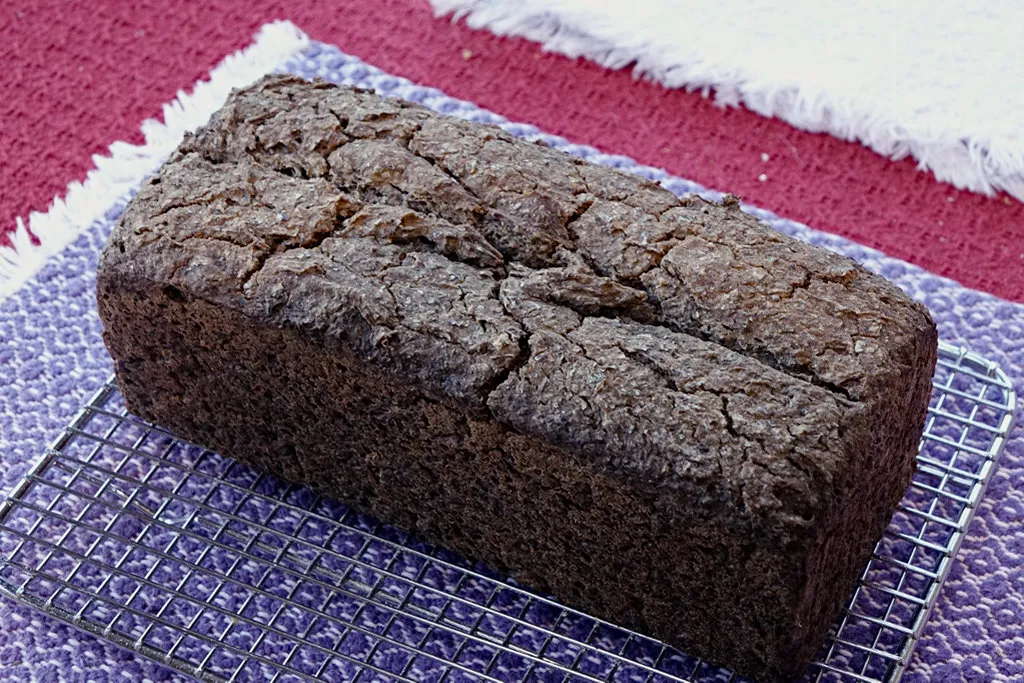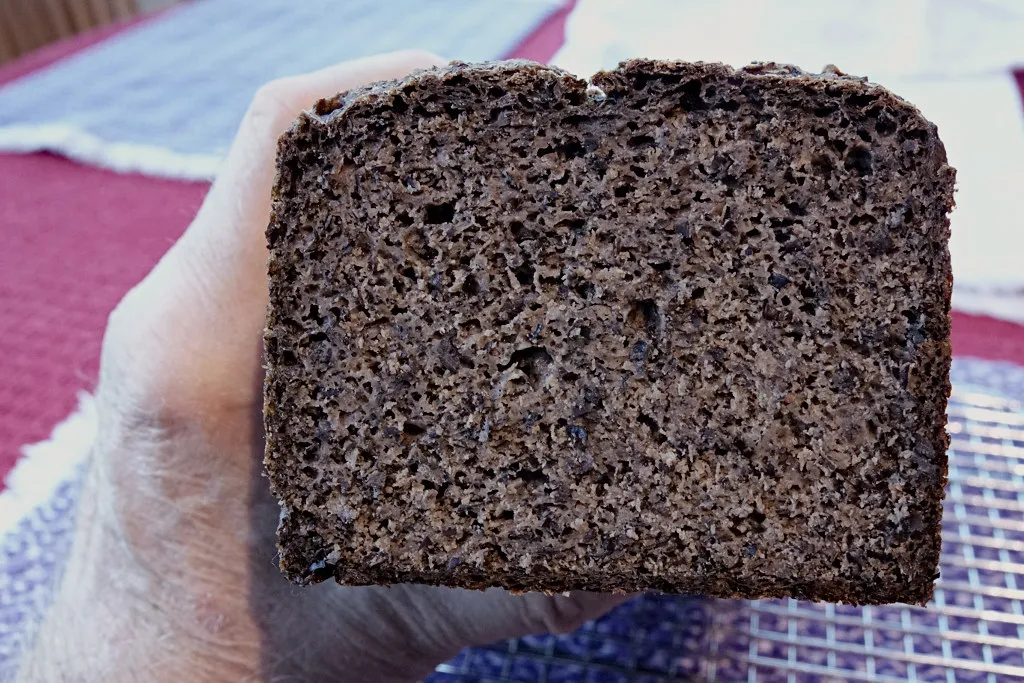
Abe showed us a stunning 100% buckwheat yeasted loaf here:
https://www.thefreshloaf.com/node/73128/community-bake-infinity-bread#comment-526712
I tried it out, with a few small changes. It worked out very well, though much darker than Abe's. It must the a difference in the flours. First pictures, then the process and changes .

This bread uses a scald of a large part of the buckwheat flour. Abe suggested using a smaller amount of the flour in the scald. I used 200g instead of his original 300g. I didn't know how much water to use in the scald. I ended up using 440g of boiling water. Later I added another 100g of tap water because the scald seemed dry.
When mixing the dough, I didn't know whether any more water would be needed. I decided to add 100g, and I warmed it to 100 deg F/38C to wake up the RapidRise yeast. Normally I don't bother to wake up the yeast but I thought that the buckwheat would probably need all the rising help it could get.
This must have been too much water because the final dough was a thick paste rather than the rye-like dough Abe wrote about. I did some bowl folds with the help of the pastry knife, and did actually develop a little strength: it stopped breaking when stretched.
Bulk ferment was a little more than an hour. The dough had visibly risen, though not by much Then I scraped the mass into my 9 inch/23cm Pullman pan and let it ferment for an hour. Initially it filled the pan to half height. At the end it had risen a little.
I baked for 70 minutes at 350 deg F/177C with no lid on the pan (a lid would have kept the moisture in and I needed to drive out as much as possible). I turned off the oven, cracked the door, and left the loaf in its pan for another 10 minutes. Then I turned the loaf out of the pan.
The loaf felt very delicate. I'm sure slicing it would have made a real mess. A few hour later it was stronger, and the next morning the loaf felt very sturdy and it was easy to cut a very thin slice. The baked loaf weight was 2.4 lb/1.07 kg.
The crumb was dense, of course, but open enough for this kind of bread as the crumb picture shows. It's not at all crumbly.
The flavor is delicious, especially toasted, but I don't know how to describe it. Not your ordinary wheat bread for sure! After you chew a piece, you are left with distinct bran bits in your mouth that feel something like softened oat bran. The flour has distinct dark bits in it, and next time I will sift them out. These bits seem to be the color of the loaf, which is very dark, darker than the pictures look I would say. The flour doesn't look that dark until it absorbs water, then it turns that very dark color.
Thanks, Abe!
TomP
exactly the kind of loaf I would love. The color looks more like what I would turn out here than Abe's. I just got a bag of buckwheat groats from Azure so I'll give this one a shot in the coming weeks.
Azure is where I got this buckwheat flour from. I need to check if they have a drop point near here so I won't have to pay all that shipping cost next time.
You fixed the issues I had with my bake. Looks like lowering the scald is the way to go. When I try this bread again that is definitely what I will do. I think the darker buckwheat which you have has more of the hull in the flour. I have found the more common light buckwheat flour and the much darker buckwheat flour but your's looks like something in-between. Your loaf, like a rye, did gain from resting a day or two. My buckwheat bread was too soft and perhaps a bit under baked (still getting used to the oven in my new apartment which seems to run at a lower temperature than given). Yours cuts very nicely and has a great crumb for buckwheat. Sliced thinly and toasted is the best way to enjoy this type of bread. Thank you for sharing your bake and ideas.
Thanks, Abe!
My buckwheat bread was too soft and perhaps a bit under baked (still getting used to the oven in my new apartment which seems to run at a lower temperature than given).
I checked the temperatures several times during baking with a probe thermometer and extended the bake time. I turned off the oven when the interior temperature reached 207 deg F/97C, and left the loaf in the oven because I knew it needed to lose more moisture no matter what the thermometer said. This plan seems to have worked perfectly.
Yours cuts very nicely and has a great crumb for buckwheat
It cuts almost like a softer pumpernickel. I'm going to have some lox and cream cheese in a toasted slice for lunch.
I'm going to have some lox and cream cheese in a toasted slice for lunch.
That was utterly delicious. The buckwheat, lox, and cream cheese play together beautifully.
And I learned something. Don't score the top of the loaf. I used Marianna's method, using a buttered table knife. It worked, but the score introduced weakness. A slice can crack starting at the score. Since the score didn't seem to help the bread open, I recommend not making one.
Toasting always makes bread better but toasting buckwheat bread really elevates the taste. It's hard to describe but it has an earthy nutty taste. I sometimes can taste a hint of smokiness. Can imagine with salty lox and creamy cheese the flavours and textures really compliment each other.
And you are 100% right. I scored and when slicing the bread does crack because of the scoring. I thought it was under proofing and the scoring opening too much but no matter how well proofed it is the scoring introduces a big fault line. Very annoying and I always thought it was something to do with proofing and/or bake. Thank you!
I always thought it [cracking at the score] was something to do with proofing and/or bake.
[Later - the rest of this post seems to have gotten lost]
The score serves as a crack starter. In a bread with a gluten network, the mesh acts as a crack-stopper, but we don't have that in this kind of bread.
You don't see it as often now but some time back this happened often and we used to refer to this as gremlins eating up the comment.
"The score serves as a crack starter. In a bread with a gluten network, the mesh acts as a crack-stopper, but we don't have that in this kind of bread".
Thank you for confirming this. This has always been my experience but wasn't sure why.
Have you tried naturally fermented buckwheat bread using whole groats?
https://www.thefreshloaf.com/node/71127/community-bake-naturally-fermented-buckwheat-bread
By far my favourite method. Something about using whole buckwheat groats makes for a better texture. And it's all a spontaneous ferment. No starter needed.
Have you tied naturally fermented buckwheat bread using whole groats?
No, but you've definitely gotten me interested...